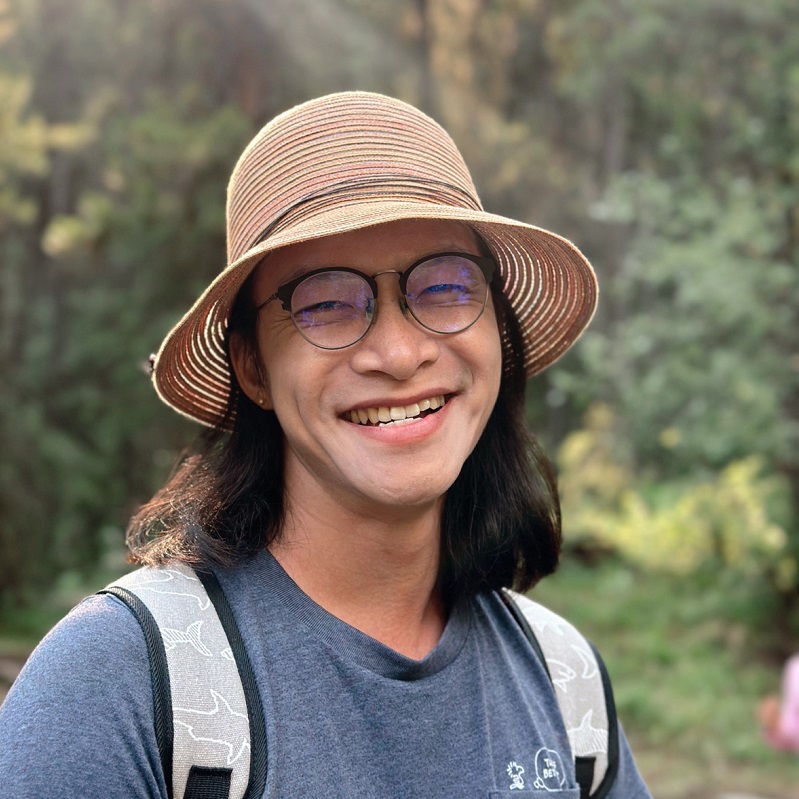
Chiou, Jian-Geng (邱澗庚)
Assistant Research Fellow
- Ph.D., Genetics and Genomics, Duke University, USA
- Developmental Patterning in Microbiology, Cell Biology, Microbiology, Developmental Biology, Biophysics, Mathematical Modeling
- jchiou@gate.sinica.edu.tw
- jchiou@as.edu.tw
- +886-2-2787-1095 (Lab: R404)
- +886-2-2787-1099 (Office: R402)
- Lab Website
- ORCID
- Web of Science (WOS)
- Google Scholar

Developmental Patterning in Microbiology
Pattern formation is a fascinating process critical in the development of multicellular organisms. During multicellular development, certain proteins need to spatially distribute in certain patterns so that cells localized at specific positions can differentiate at the precise time. Interestingly, even when the underlying molecular pathways for pattern formation are completely different between distinct phylogenetic clades, they often follow similar mathematical principles.
Since mathematical principles of pattern formation often transcend taxonomic boundaries, pattern formation principles typically discussed in the context of animal embryogenesis are also likely in play in the developmental processes of microbes that are traditionally thought of as unicellular organisms. Using interdisciplinary approaches including live cell microscopy and mathematical modeling, my lab studies the principles of pattern formation that play key roles in microbial developmental processes. Specifically, we focus on two aspects:

Cell Polarity
Different cells develop in different cell polarity modes: Pollens only grow toward one direction to develop a single pollen tube; neuron cells grow toward multiple directions when forming dendrites. Such contrasting polarity modes originate from the different spatial patterns of polarity proteins within a single cell. Previous studies have shown that the mathematical principles that govern the patterning of polarity proteins in the budding yeast (Ascomycota) follow that of a Turing system, the same principle that generates the spots and stripes on your cat! Elucidating the underlying mathematical principles of yeast cell polarity has allowed us to genetically remodel the growth of budding yeast. We changed yeast cells from uni-polar budding to multi-polar growth, resembling the branching of fungal hyphae (Chiou et al., 2021, eLife).
To our surprise, mathematical analyses predicted two additional polarity modes that are also possible from the same polarity machinery if we apply different model parameters. On the other hand, genetic and genomic data confirmed that the entire Ascomycota shares a conserved polarity machinery. Combining the two pieces of information from theory and experiments, we ask the bigger question: What if these theoretical predictions correspond to diverse polarity modes of other Ascomycete fungi? Starting from the perspective of dynamic systems theory using partial differential systems, combined with molecular genetic experiments in different fungal species, we plan to establish a unified theoretical framework for cell polarity, using Ascomycota as a model phylum.

Biofilm Development
The general textbook impression of bacteria is that they are unicellular organisms. However, most bacterial species can in fact develop into multicellular communities called biofilms. Although each bacterium in a biofilm is an individual organism, biofilm as an entity shares many surprising features with true multi-cellular organisms. Studies have shown that Bacillus subtilis cells within a biofilm can communicate with each other through electrochemical signals similar to action potential within neurons. The latest research has shown that B. subtilis biofilms can develop concentric segments driven by molecular clocks in individual bacterial cells, similar to vertebrate somitogenesis, and use this pattern to control cell differentiation.
Cell-autonomous oscillations within individual cells are the driving forces of segmentation. However, when each cell has an independent clock, the expectation of the macroscopic pattern is a field of blurred noise. To generate concentric rings with sharp boundaries, a mechanism that synchronizes and couples the clocks has to exist, just like how fireflies turn bright simultaneously on the same tree. How do molecular clocks talk to each other? Would it be electrochemical signals? We are planning to solve the key problem of synchronization under microscopic live imaging.
If you find either of these topics interesting, and you are trained as either a microbiologist, a cell biologist, or a developmental biologist, or if you have experience in physics/mathematical modeling, join us !
All publications
Selected Publications
- Chou KT*, Lee DYD*, Chiou JG*, Galera-Laporta L, Ly S, Garcia-Ojalvo J, Süel GM. A segmentation clock patterns cellular differentiation in a bacterial biofilm. Cell. 2022;185(1):145-57.e13. (*equal contributions)
- Chiou JG, Moran KD, Lew DJ. How cells determine the number of polarity sites. Elife. 2021;10.
- Lai H, Chiou JG, Zhurikhina A, Zyla TR, Tsygankov D, Lew DJ. Temporal regulation of morphogenetic events in Saccharomyces cerevisiae. Molecular Biology of the 2018:mbcE18030188.
- Chiou JG, Ramirez SA, Elston TC, Witelski TP, Schaeffer DG, Lew DJ. Principles that govern competition or co-existence in Rho-GTPase driven polarization. PLoS Computational Biology. 2018;14(4):e1006095.
- Chiou JG, Balasubramanian MK, Lew DJ. Cell Polarity in Yeast. Annual Review of Cell and Developmental Biology. 2017;33:77-101.
- Wu CF, Chiou JG, Minakova M, Woods B, Tsygankov D, Zyla TR, Lew DJ. Role of competition between polarity sites in establishing a unique front. Elife. 2015;4.
Domestic
- 2023: Emerging Young Scholars (2030 Cross-Generation Young Scholars Program) , National Science and Technology Council